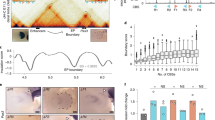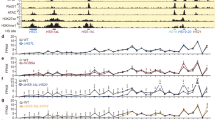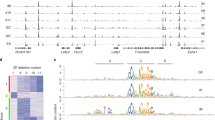Abstract
CTCF, a conserved 3D genome architecture protein, determines proper genome-wide chromatin looping interactions through directional binding to specific sequence elements of four modules within numerous CTCF-binding sites (CBSs) by its 11 zinc fingers (ZFs). Here, we report four crystal structures of human CTCF in complex with CBSs of the protocadherin (Pcdh) clusters. We show that directional CTCF binding to cognate CBSs of the Pcdh enhancers and promoters is achieved through inserting its ZF3, ZFs 4-7, and ZFs 9-11 into the major groove along CBSs, resulting in a sequence-specific recognition of module 4, modules 3 and 2, and module 1, respectively; and ZF8 serves as a spacer element for variable distances between modules 1 and 2. In addition, the base contact with the asymmetric “A” in the central position of modules 2-3, is essential for directional recognition of the CBSs with symmetric core sequences but lacking module 1. Furthermore, CTCF tolerates base changes at specific positions within the degenerated CBS sequences, permitting genome-wide CTCF binding to a diverse range of CBSs. Together, these complex structures provide important insights into the molecular mechanisms for the directionality, diversity, flexibility, dynamics, and conservation of multivalent CTCF binding to its cognate sites across the entire human genome.
Similar content being viewed by others
Log in or create a free account to read this content
Gain free access to this article, as well as selected content from this journal and more on nature.com
or
References
Rao SS, Huntley MH, Durand NC, et al. A 3D map of the human genome at kilobase resolution reveals principles of chromatin looping. Cell 2014; 159:1665–1680.
Levine M, Cattoglio C, Tjian R . Looping back to leap forward: transcription enters a new era. Cell 2014; 157:13–25.
Guo Y, Xu Q, Canzio D, et al. CRISPR inversion of CTCF sites alters genome topology and enhancer/promoter function. Cell 2015; 162:900–910.
Tang Z, Luo OJ, Li X, et al. CTCF-mediated human 3D genome architecture reveals chromatin topology for transcription. Cell 2015; 163:1611–1627.
Dekker J, Mirny L . The 3D genome as moderator of chromosomal communication. Cell 2016; 164:1110–1121.
Merkenschlager M, Nora EP . CTCF and cohesin in genome folding and transcriptional gene regulation. Annu Rev Genomics Hum Genet 2016; 17:17–43.
Narendra V, Bulajic M, Dekker J, Mazzoni EO, Reinberg D . CTCF-mediated topological boundaries during development foster appropriate gene regulation. Genes Dev 2016; 30:2657–2662.
Miller J, McLachlan AD, Klug A . Repetitive zinc-binding domains in the protein transcription factor IIIA from Xenopus oocytes. EMBO J 1985; 4:1609–1614.
Berg JM . Zinc fingers and other metal-binding domains. Elements for interactions between macromolecules. J Biol Chem 1990; 265:6513–6516.
Wolfe SA, Nekludova L, Pabo CO . DNA recognition by Cys2His2 zinc finger proteins. Annu Rev Biophys Biomol Struct 2000; 29:183–212.
Klug A . The discovery of zinc fingers and their applications in gene regulation and genome manipulation. Annu Rev Biochem 2010; 79:213–231.
Lobanenkov VV, Nicolas RH, Adler VV, et al. A novel sequence-specific DNA binding protein which interacts with three regularly spaced direct repeats of the CCCTC-motif in the 5′-flanking sequence of the chicken c-myc gene. Oncogene 1990; 5:1743–1753.
Ong CT, Corces VG . CTCF: an architectural protein bridging genome topology and function. Nat Rev Genet 2014; 15:234–246.
Nichols MH, Corces VG . A CTCF code for 3D genome architecture. Cell 2015; 162:703–705.
Huang H, Wu Q . CRISPR double cutting through the labyrinthine architecture of 3D genomes. J Genet Genomics 2016; 43:273–288.
Nora EP, Goloborodko A, Valton AL, et al. Targeted degradation of CTCF decouples local insulation of chromosome domains from genomic compartmentalization. Cell 2017; 169:930–944.
Ghirlando R, Felsenfeld G . CTCF: making the right connections. Genes Dev 2016; 30:881–891.
Dixon JR, Gorkin DU, Ren B . Chromatin domains: the unit of chromosome organization. Mol Cell 2016; 62:668–680.
Hnisz D, Day DS, Young RA . Insulated neighborhoods: structural and functional units of mammalian gene control. Cell 2016; 167:1188–1200.
Guo Y, Monahan K, Wu H, et al. CTCF/cohesin-mediated DNA looping is required for protocadherin α promoter choice. Proc Natl Acad Sci USA 2012; 109:21081–21086.
Gomez-Marin C, Tena JJ, Acemel RD, et al. Evolutionary comparison reveals that diverging CTCF sites are signatures of ancestral topological associating domains borders. Proc Natl Acad Sci USA 2015; 112:7542–7547.
Vietri Rudan M, Barrington C, Henderson S, et al. Comparative Hi-C reveals that CTCF underlies evolution of chromosomal domain architecture. Cell Rep 2015; 10:1297–1309.
de Wit E, Vos ES, Holwerda SJ, et al. CTCF binding polarity determines chromatin looping. Mol Cell 2015; 60:676–684.
Sanborn AL, Rao SS, Huang SC, et al. Chromatin extrusion explains key features of loop and domain formation in wild-type and engineered genomes. Proc Natl Acad Sci USA 2015; 112:E6456–E6465.
Kim TH, Abdullaev ZK, Smith AD, et al. Analysis of the vertebrate insulator protein CTCF-binding sites in the human genome. Cell 2007; 128:1231–1245.
Wang H, Maurano MT, Qu H, et al. Widespread plasticity in CTCF occupancy linked to DNA methylation. Genome Res 2012; 22:1680–1688.
Schmidt D, Schwalie PC, Wilson MD, et al. Waves of retrotransposon expansion remodel genome organization and CTCF binding in multiple mammalian lineages. Cell 2012; 148:335–348.
Nakahashi H, Kwon KR, Resch W, et al. A genome-wide map of CTCF multivalency redefines the CTCF code. Cell Rep 2013; 3:1678–1689.
Hansen AS, Pustova I, Cattoglio C, Tjian R, Darzacq X . CTCF and cohesin regulate chromatin loop stability with distinct dynamics. Elife 2017; 6:e25776.
Rhee HS, Pugh BF . Comprehensive genome-wide protein-DNA interactions detected at single-nucleotide resolution. Cell 2011; 147:1408–1419.
Quitschke WW, Taheny MJ, Fochtmann LJ, Vostrov AA . Differential effect of zinc finger deletions on the binding of CTCF to the promoter of the amyloid precursor protein gene. Nucleic Acids Res 2000; 28:3370–3378.
Renda M, Baglivo I, Burgess-Beusse B, et al. Critical DNA binding interactions of the insulator protein CTCF: a small number of zinc fingers mediate strong binding, and a single finger-DNA interaction controls binding at imprinted loci. J Biol Chem 2007; 282:33336–33345.
Kemp CJ, Moore JM, Moser R, et al. CTCF haploinsufficiency destabilizes DNA methylation and predisposes to cancer. Cell Rep 2014; 7:1020–1029.
Katainen R, Dave K, Pitkanen E, et al. CTCF/cohesin-binding sites are frequently mutated in cancer. Nat Genet 2015; 47:818–821.
Ji X, Dadon DB, Powell BE, et al. 3D chromosome regulatory landscape of human pluripotent cells. Cell Stem Cell 2016; 18:262–275.
Wu Q, Maniatis T . A striking organization of a large family of human neural cadherin-like cell adhesion genes. Cell 1999; 97:779–790.
Zipursky SL, Sanes JR . Chemoaffinity revisited: Dscams, protocadherins, and neural circuit assembly. Cell 2010; 143:343–353.
Chen WV, Nwakezw CL, Denny CA, et al. Pcdhαc2 is required for axonal tiling and assembly of serotonergic circuitries in mice. Science 2017; 356:406–411.
Wu Q, Zhang T, Cheng JF, et al. Comparative DNA sequence analysis of mouse and human protocadherin gene clusters. Genome Res 2001; 11:389–404.
Nolte RT, Conlin RM, Harrison SC, Brown RS . Differing roles for zinc fingers in DNA recognition: structure of a six-finger transcription factor IIIA complex. Proc Natl Acad Sci USA 1998; 95:2938–2943.
Hashimoto H, Wang D, Horton JR, et al. Structural basis for the versatile and methylation-dependent binding of CTCF to DNA. Mol Cell 2017; 66:711–720.
Pavletich NP, Pabo CO . Zinc finger-DNA recognition: crystal structure of a Zif268-DNA complex at 2.1 Å. Science 1991; 252:809–817.
Bedard M, Roy V, Montagne M, Lavigne P . Structural insights into c-Myc-interacting zinc finger protein-1 (Miz-1) delineate domains required for DNA scanning and sequence-specific binding. J Biol Chem 2017; 292:3323–3340.
MacPherson MJ, Sadowski PD . The CTCF insulator protein forms an unusual DNA structure. BMC Mol Biol 2010; 11:101.
Yusufzai TM, Tagami H, Nakatani Y, Felsenfeld G . CTCF tethers an insulator to subnuclear sites, suggesting shared insulator mechanisms across species. Mol Cell 2004; 13:291–298.
Bell AC, Felsenfeld G . Methylation of a CTCF-dependent boundary controls imprinted expression of the Igf2 gene. Nature 2000; 405:482–485.
Hark AT, Schoenherr CJ, Katz DJ, et al. CTCF mediates methylation-sensitive enhancer-blocking activity at the H19/Igf2 locus. Nature 2000; 405:486–489.
Wang QS, Yu F, Huang S, et al. The macromolecular crystallography beamline of SSRF. Nucl Sci Tech 2015; 26:12–17.
Otwinowski Z, Minor W . Processing of X-ray diffraction data collected in oscillation mode. Methods Enzymol 1997; 276:307–326.
Adams PD, Grosse-kunstleve RW, Hung LW, et al. PHENIX: building new software for automated crystallographic structure determination. Acta Crystallogr D Biol Crystallogr 2002; 58:1948–1954.
Emsley P, Lohkamp B, Scott WG, Cowtan K . Features and development of Coot. Acta Crystallogr D Biol Crystallogr 2010; 66:486–501.
He Q, Johnston J, Zeitlinger J . ChIP-nexus enables improved detection of in vivo transcription factor binding footprints. Nat Biotechnol 2015; 33:395–401.
Langmead B, Salzberg SL . Fast gapped-read alignment with Bowtie 2. Nat Methods 2012; 9:357–359.
Zhang Y, Liu T, Meyer CA, et al. Model-based analysis of ChIP-Seq (MACS). Genome Biol 2008; 9:R137.
Bailey TL, Boden M, Buske FA, et al. MEME SUITE: tools for motif discovery and searching. Nucleic Acids Res 2009; 37:W202–W208.
Acknowledgements
We thank the staffs from BL18U1 and BL19U1 beamlines of National Center for Protein Science Shanghai (NCPSS) at Shanghai Synchrotron Radiation Facility (SSRF), and staffs of BL-17U1 beamline at SSRF for assistance with data collection. We thank Dr Lingling Chen (Institute of Biochemistry and Cell Biology, Shanghai) for providing the human CTCF construct. We thank Hongjie Zhang at the IBP radioactive isotope laboratory for the guidance in handling radiolabeled chemicals. We also thank Dr Torsten Juelich for critical reading of the manuscript and linguistic assistance. This work was supported by the Ministry of Science and Technology of China (2017YFA0504203 and 2014CB910102), the National Natural Science Foundation of China (31630015, 91440201, 31571335, 31400640, 31630039, 91640118 and 31470820), the Science and Technology Commission of Shanghai Municipality (14JC1403601), and the Strategic Priority Research Program of the Chinese Academy of Sciences (XDB08010203).
Author information
Authors and Affiliations
Corresponding authors
Additional information
( Supplementary information is linked to the online version of the paper on the Cell Research website.)
Supplementary information
Supplementary information, Figure S1
Orientation of diverse CBS repertoires conserved in the promoter and enhancer regions of the three human Pcdh gene clusters. (PDF 952 kb)
Supplementary information, Figure S2
Crystal structure of CTCF ZFs 4-8 bound the DNA HS5-1a. (PDF 759 kb)
Supplementary information, Figure S3
Crystal structure of CTCF ZFs 4-8 bound the eCBS of the Pcdhα8 promoter. (PDF 634 kb)
Supplementary information, Figure S4
Three types of diverse CBSs in the human genome revealed by ChIP-nexus. (PDF 547 kb)
Supplementary information, Figure S5
Crystal structure of CTCF ZFs 6-11 bound to DNA γb7CSE, which contains module 1 and modules 2-3. (PDF 480 kb)
Supplementary information, Figure S6
In vivo mapping of CTCF binding borders by ChIP-nexus. (PDF 1771 kb)
Supplementary information, Figure S7
Molar mass determination of CTCF-HS5-1aR by static light scattering. (PDF 509 kb)
Supplementary information, Table S1
Crystallographic data collection and refinement statistics. (PDF 145 kb)
Rights and permissions
About this article
Cite this article
Yin, M., Wang, J., Wang, M. et al. Molecular mechanism of directional CTCF recognition of a diverse range of genomic sites. Cell Res 27, 1365–1377 (2017). https://doi.org/10.1038/cr.2017.131
Received:
Revised:
Accepted:
Published:
Issue date:
DOI: https://doi.org/10.1038/cr.2017.131
Keywords
This article is cited by
-
Multimeric transcription factor BCL11A utilizes two zinc-finger tandem arrays to bind clustered short sequence motifs
Nature Communications (2025)
-
Increasingly efficient chromatin binding of cohesin and CTCF supports chromatin architecture formation during zebrafish embryogenesis
Nature Communications (2025)
-
Structural insights into a highly flexible zinc finger module unravel INSM1 function in transcription regulation
Nature Communications (2025)
-
CTCF mutation at R567 causes developmental disorders via 3D genome rearrangement and abnormal neurodevelopment
Nature Communications (2024)
-
Multifaceted role of CTCF in X-chromosome inactivation
Chromosoma (2024)



